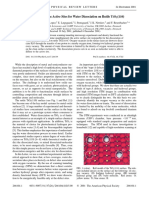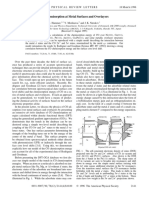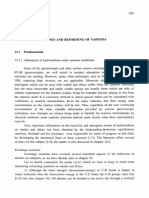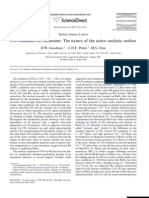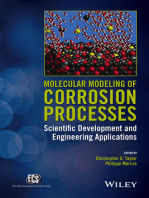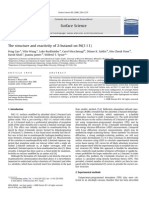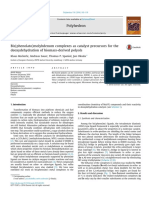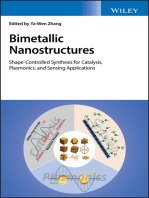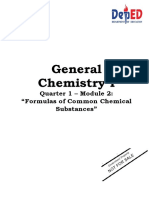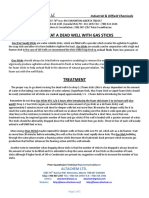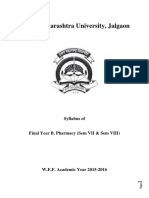Hydrogen Dissociation and Spillover On Individual Isolated Palladium Atoms
Hydrogen Dissociation and Spillover On Individual Isolated Palladium Atoms
Uploaded by
Muhammad Faiz Ur RehmanCopyright:
Available Formats
Hydrogen Dissociation and Spillover On Individual Isolated Palladium Atoms
Hydrogen Dissociation and Spillover On Individual Isolated Palladium Atoms
Uploaded by
Muhammad Faiz Ur RehmanOriginal Title
Copyright
Available Formats
Share this document
Did you find this document useful?
Is this content inappropriate?
Copyright:
Available Formats
Hydrogen Dissociation and Spillover On Individual Isolated Palladium Atoms
Hydrogen Dissociation and Spillover On Individual Isolated Palladium Atoms
Uploaded by
Muhammad Faiz Ur RehmanCopyright:
Available Formats
PRL 103, 246102 (2009)
PHYSICAL REVIEW LETTERS
week ending 11 DECEMBER 2009
Hydrogen Dissociation and Spillover on Individual Isolated Palladium Atoms
Heather L. Tierney,1 Ashleigh E. Baber,1 John R. Kitchin,2 and E. Charles H. Sykes1,*
Department of Chemistry, Tufts University, Medford, Massachusetts 02155-5813, USA Department of Chemical Engineering, Carnegie Mellon University, Pittsburgh, Pennsylvania 15213, USA (Received 24 November 2008; revised manuscript received 2 October 2009; published 10 December 2009)
2 1
Using a combination of low-temperature scanning tunneling microscopy and density functional theory it is demonstrated how the nature of an inert host metal of an alloy can affect the thermodynamics and kinetics of a reaction pathway in a much more profound way than simply a dilution, electronic, or geometric effect. This study reveals that individual, isolated Pd atoms can promote H2 dissociation and spillover onto a Cu(111) surface, but that the same mechanism is not observed for an identical array of Pd atoms in Au(111).
DOI: 10.1103/PhysRevLett.103.246102 PACS numbers: 68.37.Ef, 68.35.bd, 68.43.h, 81.05.Bx
Metal alloys are unique materials with properties that can stray far from those of their constituent elements. Alloys are often heterogeneous at the atomic scale and a complex electronic and geometric interplay between the atoms of the various elements yields new and useful material properties. In these systems the electronic interactions between the different elements in an alloy (ligand effects), the change in lattice parameters due to alloying (strain effects), and the spatial distribution of atomic sites (ensemble effects) inuence the distinctive physical and electronic features which make alloys so appealing [1,2]. Alloying is often used in elds such as catalysis or metallurgy to dilute an expensive, reactive material in a cheaper, more inert host. In this way the character of the minority element can still dominate the material properties without the higher cost of a pure metal component. This property is extremely useful in heterogeneous catalysis, where reaction rates and pathways can be altered by tuning the alloy composition [35]. A common explanation for such behavior is that the reaction of interest can still be catalyzed by the minority active component; however, mixing in a more passive host allows products to be released more easily. This approach can even lead to enhanced reaction rates and selectivities [3,6,7]. One key reaction step in which alloy catalysts are often employed is the dissociation of molecular hydrogen, which is a crucial part of a number of energy-related technologies including the hydrogenation of CO2 , water gas shift catalysis, and hydrogen separation [810]. In methanol synthesis the most common metal used as a catalyst is Cu [11]. H2 dissociation on pure Cu is activated and occurs very slowly unless high pressures and temperatures are used to drive the reactions [12]. Hydrogen dissociation on Pt-group metals, in contrast, is facile and occurs readily at room temperature and ambient pressures. These observations suggest that a bifunctional catalyst composed of a relatively inert metal such as Cu or Au with a minority Pt-group metal component that can readily dissociate hydrogen may be a superior catalyst when hydrogen is a 0031-9007=09=103(24)=246102(4)
reactive species, but the catalysis would primarily occur on the host metal. The atomic-scale geometric and reactive properties of small amounts of Pd alloyed with both Cu and Au(111) host surfaces were investigated in this work using lowtemperature scanning tunneling microscopy (STM) and density functional theory (DFT). This study shows how Pd atoms can modify both the ability of these surfaces to dissociate hydrogen and the subsequent hydrogen atom spillover from the Pd sites onto the host surfaces. These results demonstrate that individual, isolated Pd atoms are active for the dissociation of H2 if supported in the correct host. Isolated Pd atoms alloyed into Cu(111) and Au(111) hosts were synthesized by physical vapor deposition of small amounts of Pd onto the clean surfaces during controlled annealing. In agreement with previous studies [3,13], no Pd-Pd dimers were observed at low Pd coverages; the Pd atoms were always surrounded by either Cu or Au neighbors. These isolated Pd sites have been shown to be active for catalytic reactions such as vinyl acetate synthesis on Pd=Au111 [3,14]. In both surfaces it was also possible to distinguish between individual Pd atoms in the surface layer (which appeared as protrusions) and subsurface Pd atoms in the layer below the surface (which appeared as depressions), in good agreement with previous STM studies of similar bimetallic near-surface alloys [13,15,16]. Alloying begins at the step edges in a Cu substrate as shown in Fig. 1(a), suggesting that Pd adatoms are mobile on the terraces until they collide with an ascending step edge where they adsorb and are incorporated into the surface or subsurface [13,16]. Figure 1(b) shows a Au(111) p surface with the 22 3, or herringbone reconstruction, after deposition of Pd. On the Au(111) surface, the elbows of the herringbone reconstruction act as sites for the place exchange of Pd atoms before the Pd disperses into the surface and subsurface layers [inset of Fig. 1(b)]. In order to compare the properties of isolated Pd atoms in both Cu 2009 The American Physical Society
246102-1
PRL 103, 246102 (2009)
PHYSICAL REVIEW LETTERS
week ending 11 DECEMBER 2009
FIG. 1 (color online). STM images of Pd alloyed surfaces at 78 K. (a) In the Cu(111) surface, Pd alloys preferentially at the step edges and forms brims (scale bar 20 nm, I 0:1 nA, Vtip 0:4 V). Inset: atomic resolution of the Cu=Pd alloy shows individual Pd atoms in the surface layer appearing as protrusions while subsurface Pd atoms image as depressions (scale bar 1 nm, I 0:9 nA, Vtip 0:04 V). (b) Pd incorporation into a Au(111) surface leads to place exchange at the elbows of the herringbone surface reconstruction (scale bar 4 nm, I 1:5 nA, Vtip 0:1 V). Inset: atomic resolution of Pd=Au111 shows a similar appearance of the Pd atoms, where surface Pd atoms image as protrusions and subsurface Pd atoms appear as depressions (scale bar 1 nm, I 0:4 nA, Vtip 0:1 V).
FIG. 2 (color online). H on Pd=Cu111 imaged at 7 K. STM image of Pd=Cu111 after depositing 10 L of H2 shows islands of H atoms that have spilled over onto pure Cu(111) areas (scale bar 15 nm, I 10 pA, Vtip 8 mV). Inset: individual H atoms appear as depressions (scale bar 5 nm, I 50 pA, Vtip 20 mV).
and Au, each of the alloy systems was dosed with the same amount of Pd [0.01 monolayer (ML)] at a temperature that yielded $50% surface and 50% subsurface Pd. After exposure to 10 L (where 1 L 1 106 Torr s) of H2 at 420 K, no hydrogen dissociation was observed on the bare Cu(111) surface, which is consistent with previous reports [17]. However, after 0.01 ML Pd was alloyed into the Cu(111) surface and exposed to the same amount of hydrogen at 420 K, a large amount of hydrogen was present on the surface. STM imaging after cooling the sample to 7 K revealed that these H atoms clustered into islands as shown in Fig. 2 [18]. Salmeron and co-workers reported that for H coverages near 1 ML, three vacant sites around a Pd atom are required for hydrogen dissociation on Pd(111) [19]. The results presented here do not contradict the work of Salmeron et al., but show the interesting effect that in the low H coverage regime individual, isolated Pd atoms are very efcient at dissociating molecular hydrogen. Extensive STM imaging revealed a sharp decrease in H coverage further from the Pd atoms, which is consistent with H2 dissociation occurring at the Pd atom sites. In contrast to the Cu surface, no hydrogen atoms were observed on a Au(111) surface containing an identical amount of Pd atoms after exposure to the same H2 ux. The stability of isolated Pd atoms in Cu and Au(111) was investigated using density functional theory. The heat of formation was calculated for 21 different clean surface alloy congurations with compositions spanning from pure host (Cu or Au) to a full monolayer of Pd on the surface of the host. The lattice constant of the surface was xed to the lattice constant of the host, which was also calculated using
density functional theory (Cu 3.67 A, Au 4.18 A). Pd exothermically alloys into both Cu and Au(111) surfaces. At coverages below xPd 0:4, Pd atoms are most thermodynamically stable when surrounded by Cu or Au atoms, consistent with exothermic alloy formation and maximization of Pd-Cu or Pd-Au bonds. These results are consistent with STM observations in this study and others [13,16]. The Pd alloy surfaces have a distribution of different active sites where hydrogen atoms can adsorb, including sites with and without the Pd atom present. The preferential adsorption site for hydrogen is the threefold fcc hollow site [20,21]. The adsorption energies of hydrogen were modeled on a 3 2 4 layer fcc(111) surface. The slab surfaces were separated by 10 A of vacuum space and the Brillouin zone was sampled by an 8 6 1 Monkhorst-Pack grid. The stability of hydrogen was calculated in the fcc hollow sites of alloys containing an individual Pd atom in both Cu(111) and Au(111) host surfaces. H atoms located on a Pd fcc site were labeled S1, with a H atom on one Pd and two host metal atoms. As the H moved away from the Pd by one fcc site onto the host metal a calculation was performed for this site, labeled S2, with the H located on three host metal atoms. Finally the energy was calculated for a site with only the host metal and no Pd contributions, labeled M111. The PerdewWang 1991 (PW91) exchange-correlation functional was utilized to calculate the adsorption energies. The adsorption energies were also calculated using the Perdew-BurkeErnzerhof (PBE), revised Perdew-Burke-Ernzerhof (revPBE), and alternative revised Perdew-BurkeErnzerhof (RPBE) functionals non-self-consistently [22] to evaluate the sensitivity of the results to the exchangecorrelation functional. The PW91 and RPBE functionals are expected to span the range of expected values with
246102-2
PRL 103, 246102 (2009)
PHYSICAL REVIEW LETTERS
week ending 11 DECEMBER 2009
FIG. 3 (color online). Graphical summary of dissociative H adsorption on Pd alloy surfaces (a) at 0 K and (b) 420 K. S1 is an fcc site containing an isolated Pd atom, S2 is an fcc site near the Pd atom, and M111 refers to the pure host metal surface. The solid symbols correspond to free energies corrected for zeropoint energies, pressures, and temperature. The open circles are DFT adsorption energies at 0 K calculated with the RPBE, revPBE, PW91, and PBE exchange-correlation functionals. H adatoms are stable at Pd sites in both Cu and Au(111), but diffusion away from the Pd atoms is thermodynamically unfavorable on Au(111) at 0 K.
PW91 yielding the most stable energies and RPBE yielding the weaker range of energies [23]. These results are summarized in Fig. 3. The exchange-correlation functionals all yielded the same trends in adsorption energies with a variation of 0:090:16 eV=H between PW91 and RPBE for each site. Here only the PW91 results are discussed. Hydrogen favorably adsorbs on the Pd S1 site with an adsorption energy with respect to molecular hydrogen ( 1 H2 ! H ) of 2 0:24 eV=H. The adsorption energy on the neighboring S2 site is 0:14 eV=H, which is slightly weaker than the adsorption energy of hydrogen on Cu(111). In contrast to Cu(111), hydrogen dissociation is endothermic on Au(111). Hydrogen favorably adsorbs at isolated Pd atoms in Au(111) (S1) with an adsorption energy of 0:15 eV=H, although the RPBE functional suggests the adsorption may be slightly unfavorable at 0:01 eV=H. The hydrogen adsorption energy at S2 is 0:07 eV=H indicating that molecular desorption of H2 is thermodynamically favorable. It is not surprising in this context that after deposition of H2 at identical conditions to the Pd=Cu111 data, no hydrogen spillover was observed on either the Au(111) or the Pd=Au111 surfaces. The free energies of adsorption have also been considered to incorporate the effects of zero-point energy, pressure, and temperature using standard atomistic thermodynamics [24,25] and the PW91 adsorption energies discussed above. At 0 K, the free adsorption energies are slightly weaker than the DFT adsorption energies due to the zero-point energies of the adsorbate and the H2 mole-
cule. At 420 K, however, the adsorption energies are substantially reduced due to entropy in molecular hydrogen, and the calculations suggest that dissociative adsorption of hydrogen is highly unfavorable on the Au host but only slightly unfavorable on the Cu host. Dissociative adsorption on Cu is favorable at temperatures less than 420 K. The dissociation and diffusion barriers between some of the key adsorption sites were also investigated. The dissociation barrier for H2 on Cu(111) has been calculated to be 0.5 eV [26], although experimental estimates put the barrier in the range of 0.30.4 eV [17,27]. The same method in Ref. [26] has been used to calculate the dissociation barrier over an isolated Pd atom in Cu(111) and a barrier of only 0.02 eV was obtained. Although this method may underestimate the barrier, it suggests the existence of a very low barrier dissociation pathway over the Pd atom, consistent with the experimental observations of efcient dissociative adsorption at 420 K in the presence of individual, isolated Pd atoms. Nudged elastic band calculations were used to estimate barriers for the adsorbed H atoms to diffuse away from Pd. The calculated barriers were in the range 0.120.15 eV from the weaker adsorption energy site to the stronger adsorption energy site. Diffusion barriers were previously reported on late transition metals in the range of 0.12 0.18 eV, and were found to be correlated with adsorption energies of both the initial and nal sites [28]. The calculated and estimated dissociation and diffusion barriers are summarized in Fig. 4, where two possible spillover mechanisms are examined. Both mechanisms are feasible, illustrating how dissociative H2 adsorption can be catalyzed by individual, isolated Pd atoms supported in the correct host. The understanding that emerges from these results is that hydrogen dissociation is thermodynamically feasible on
FIG. 4 (color online). Kinetics and thermodynamics of feasible H spillover pathways from individual, isolated Pd atoms to Cu. The lighter circles represent barriers calculated in this work. The darker diamonds are barriers taken from the literature [26,28]. Schematics: The dark (orange) circles represent Cu atoms, the black circle (blue) indicates isolated Pd atoms, and the small white circles are H atoms.
246102-3
PRL 103, 246102 (2009)
PHYSICAL REVIEW LETTERS
week ending 11 DECEMBER 2009
isolated Pd atoms in Cu(111) and Au(111). Spillover is activated and feasible on Cu(111) but thermodynamically infeasible on Au(111) due to desorption of molecular hydrogen. This work also indicates that the hydrogen dissociation barrier is high on Cu(111), where negligible hydrogen dissociation is observed experimentally, and that the barrier is a great deal lower at Pd sites, where signicant dissociation and spillover is observed under the same experimental conditions. These results reveal that small amounts of individual, isolated Pd atoms can efciently dissociate H2 and allow it to spill over onto an appropriate host metal. While it is known that H spillover can occur from Pd to Cu sites in the synthesis of methanol [29,30], the results from our study demonstrate that this approach is more general and that multiple alloy combinations can be surveyed theoretically in an identical manner in order to identify potential candidate systems. Careful selection of the host metal and the catalytically active atom in an alloyed system will enable dissociation and spillover of species that typically do not react due to high kinetic barriers (e.g., O2 on Au). Such bifunctional alloy catalyst surfaces will yield tunable catalytic properties such as stability, adsorption energy, and spillover barrier. J. R. K. gratefully acknowledges partial support of this work by the Ofce of Basic Energy Science of the U.S. Department of Energy (Grant No. DOE-BES DEFG0207ER15919). H. L. T., A. E. B., and E. C. H. S. thank the NSF (Grant No. 0717978), the Beckman Foundation, and Research Corporation.
*charles.sykes@tufts.edu [1] J. G. Chen, C. A. Menning, and M. B. Zellner, Surf. Sci. Rep. 63, 201 (2008). [2] J. A. Rodriguez, Surf. Sci. Rep. 24, 223 (1996).
[3] M. S. Chen et al., Science 310, 291 (2005). [4] M. O. Pedersen et al., Surf. Sci. 426, 395 (1999). [5] J. Greeley and M. Mavrikakis, Nature Mater. 3, 810 (2004). [6] F. Gao et al., J. Phys. Chem. C 112, 3362 (2008). [7] C. J. Baddeley et al., J. Phys. Chem. 99, 5146 (1995). [8] K. I. Choi and M. A. Vannice, J. Catal. 131, 36 (1991). [9] J. Greeley et al., Chem. Phys. Chem. 7, 1032 (2006). [10] P. Kamakoti et al., Science 307, 569 (2005). [11] X. M. Liu et al., Ind. Eng. Chem. Res. 42, 6518 (2003). [12] B. Hammer and J. K. Norskov, Nature (London) 376, 238 (1995). [13] A. B. Aaen et al., Surf. Sci. 408, 43 (1998). [14] P. Han et al., J. Am. Chem. Soc. 129, 14355 (2007). [15] J. Knudsen et al., J. Am. Chem. Soc. 129, 6485 (2007). [16] D. O. Bellisario et al., J. Phys. Chem. C 113, 5895 (2009). [17] T. Kammler and J. Kuppers, J. Chem. Phys. 111, 8115 (1999). [18] S. Rauber et al., Surf. Sci. 123, 173 (1982). [19] T. Mitsui et al., Nature (London) 422, 705 (2003). [20] M. F. Luo, G. R. Hu, and M. H. Lee, Surf. Sci. 601, 1461 (2007). [21] V. Pallassana et al., Phys. Rev. B 60, 6146 (1999). [22] B. Hammer, L. B. Hansen, and J. K. Norskov, Phys. Rev. B 59, 7413 (1999). [23] K. Honkala et al., Science 307, 555 (2005). [24] J. R. Kitchin, K. Reuter, and M. Schefer, Phys. Rev. B 77, 075437 (2008). [25] K. Reuter and M. Schefer, Phys. Rev. B 65, 035406 (2001). [26] B. Hammer and J. K. Nrskov, Nature (London) 376, 238 (1995). [27] K. D. Rendulic and A. Winkler, Surf. Sci. 299300, 261 (1994). [28] A. U. Nilekar, J. Greeley, and M. Mavrikakis, Angew. Chem., Int. Ed. 45, 7046 (2006). [29] D. Lee et al., Catal. Today 111, 373 (2006). [30] I. Melian-Cabrera et al., Catal. Today 45, 251 (1998).
246102-4
You might also like
- HAT Guide For HEC Indigenous Scholarship PDFDocument340 pagesHAT Guide For HEC Indigenous Scholarship PDFMuhammad Faiz Ur Rehman0% (2)
- Metal Prep Brochure CC-T1 - FINAL 02-14Document7 pagesMetal Prep Brochure CC-T1 - FINAL 02-14Selvia María Tamez ZamoraNo ratings yet
- Electronic Factors Determining The Reactivity of Metal SurfacesDocument10 pagesElectronic Factors Determining The Reactivity of Metal SurfacesLuca BrunoNo ratings yet
- Cold Storage Management, Standard Operating ProceduresDocument10 pagesCold Storage Management, Standard Operating ProceduresW MoralesNo ratings yet
- Modeling The Adsorption of CO On Small PT, Fe and Co Clusters For The Fischer-Tropsch SynthesisDocument14 pagesModeling The Adsorption of CO On Small PT, Fe and Co Clusters For The Fischer-Tropsch SynthesisLilian PaesNo ratings yet
- Trends in Catalytic Activity For SOFC Anode MaterialsDocument7 pagesTrends in Catalytic Activity For SOFC Anode MaterialssharatNo ratings yet
- Oxygen Vacancies As Active Sites For Water Dissociation On Rutile TioDocument4 pagesOxygen Vacancies As Active Sites For Water Dissociation On Rutile TioiprateekNo ratings yet
- Real DFT Model On Co Adsorption by Noble CatalystDocument52 pagesReal DFT Model On Co Adsorption by Noble CatalystDikra BkNo ratings yet
- Environmental Photochemistry: Is Iron Oxide (Hematite) An Active Photocatalyst? A Comparative Study: A-Fe20,, Zno, Ti02Document9 pagesEnvironmental Photochemistry: Is Iron Oxide (Hematite) An Active Photocatalyst? A Comparative Study: A-Fe20,, Zno, Ti02Kristanto WahyudiNo ratings yet
- CO Chemisorption at Metal Surfaces and Overlayers: Olume UmberDocument4 pagesCO Chemisorption at Metal Surfaces and Overlayers: Olume UmberLuca BrunoNo ratings yet
- Oxygen Reduction at Platinum Nanoparticles Supported On Carbon Cryogel in Alkaline SolutionDocument10 pagesOxygen Reduction at Platinum Nanoparticles Supported On Carbon Cryogel in Alkaline Solutionlkrao1No ratings yet
- Chapter 5Document23 pagesChapter 5eimaiokanenasNo ratings yet
- Oxigen ReducionDocument5 pagesOxigen ReducionRafael Ricardo Celin ManceraNo ratings yet
- Catalytic Activity of Au NanoparticlesDocument5 pagesCatalytic Activity of Au NanoparticlesNAKULKARLENo ratings yet
- 0 - Synthesis of Cis and TransDocument13 pages0 - Synthesis of Cis and TransTen Chittaphon LeechaiyapornkulNo ratings yet
- 1 UNIT 5 (Nurul Inayah)Document18 pages1 UNIT 5 (Nurul Inayah)azizah.irwansyah27No ratings yet
- A Polyoxometallate-Templated Coordination Polymer: Synthesis and Crystal Structure of (Cu (4,4 (Mecn) ) PW O 2C H CNDocument2 pagesA Polyoxometallate-Templated Coordination Polymer: Synthesis and Crystal Structure of (Cu (4,4 (Mecn) ) PW O 2C H CNEvelyn Ruales DávilaNo ratings yet
- H2 Atomic Structure, Stiochiometry QuestionsDocument8 pagesH2 Atomic Structure, Stiochiometry QuestionskitoniumNo ratings yet
- 1 s2.0 S0360319901001598 Main PDFDocument6 pages1 s2.0 S0360319901001598 Main PDFDr ChNo ratings yet
- CO Oxidation On Gold nanoparticles-Remediakis-2005IMPORTDocument8 pagesCO Oxidation On Gold nanoparticles-Remediakis-2005IMPORTleonardoNo ratings yet
- Reactions of Alkanes and Reforming of NaphthaDocument95 pagesReactions of Alkanes and Reforming of NaphthaHenrique SouzaNo ratings yet
- WGS Article 1Document12 pagesWGS Article 1cymyNo ratings yet
- Jurnal ElektrolisisDocument8 pagesJurnal ElektrolisisMoch Alie MuchitNo ratings yet
- The Kinetics of Oxygen Electroreduction: A Long Way From Iron Rust To Lithium-Air BatteriesDocument6 pagesThe Kinetics of Oxygen Electroreduction: A Long Way From Iron Rust To Lithium-Air BatteriesCristian GonzálezNo ratings yet
- Advances in Catalysis Volume 22 - D.D. Eley (Academic Press, 1972)Document365 pagesAdvances in Catalysis Volume 22 - D.D. Eley (Academic Press, 1972)Ivana VidanovicNo ratings yet
- Understanding The Effect of Steps, Strain, Poisons, and Alloying: Methane Activation On Ni SurfacesDocument5 pagesUnderstanding The Effect of Steps, Strain, Poisons, and Alloying: Methane Activation On Ni SurfacesAndrés CarranzaNo ratings yet
- The Bonding, Structure and Reactions of CO2 Adsorbed On Clean and Promoted Metal SurfacesDocument22 pagesThe Bonding, Structure and Reactions of CO2 Adsorbed On Clean and Promoted Metal Surfacesleminhlan19214565No ratings yet
- Fulltext 12Document9 pagesFulltext 12hoangPDANo ratings yet
- Surface Oxides On Carbon and Their Analysis: A Critical AssessmentDocument5 pagesSurface Oxides On Carbon and Their Analysis: A Critical AssessmentJéssica Caroline Zanette BarbieriNo ratings yet
- 3 - Electrochem Acta 52 385 (2006)Document9 pages3 - Electrochem Acta 52 385 (2006)Érico Teixeira NetoNo ratings yet
- CO Oxidation Over PD Supported Catalysts - in Situ Study of The ElectricDocument8 pagesCO Oxidation Over PD Supported Catalysts - in Situ Study of The ElectricPatrick Tejada AdriazolaNo ratings yet
- Hydrogen-Bonded Cyclic Water Clusters Nucleated On An Oxide SurfaceDocument6 pagesHydrogen-Bonded Cyclic Water Clusters Nucleated On An Oxide SurfacegonelgoktugNo ratings yet
- Applied Surface Science: Jiake Cui, Xiaojing Liu, Yifeng Wang, Dandan Song, Yugang Ren, Xiangjian ShenDocument8 pagesApplied Surface Science: Jiake Cui, Xiaojing Liu, Yifeng Wang, Dandan Song, Yugang Ren, Xiangjian ShenChinh Asen LupinNo ratings yet
- Copper Ion-Exchanged Zeolite Catalysts in Deno Reaction: Hidenori Yahiro, Masakazu IwamotoDocument19 pagesCopper Ion-Exchanged Zeolite Catalysts in Deno Reaction: Hidenori Yahiro, Masakazu IwamotoborgiamatriceNo ratings yet
- Aenm202103750 Sup 0001 SuppmatDocument28 pagesAenm202103750 Sup 0001 SuppmatAref 12345No ratings yet
- Charge-Enhanced Dry Impregnation: A Simple Way To Improve The Preparation of Supported Metal CatalystsDocument6 pagesCharge-Enhanced Dry Impregnation: A Simple Way To Improve The Preparation of Supported Metal CatalystsRicardo FlórezNo ratings yet
- Models - Corr.co2 CorrosionDocument18 pagesModels - Corr.co2 CorrosionCalberttNo ratings yet
- Fuel Cell HandbookDocument18 pagesFuel Cell HandbookDiego AranibarNo ratings yet
- Tejel Et Al-2012-Chemistry (Weinheim An Der Bergstrasse, Germany)Document4 pagesTejel Et Al-2012-Chemistry (Weinheim An Der Bergstrasse, Germany)Claudia Urbina GhinelliNo ratings yet
- CO Oxidation On Ruthenium The Nature of The Active Catalytic SurfaceDocument3 pagesCO Oxidation On Ruthenium The Nature of The Active Catalytic SurfacesadeghiniaNo ratings yet
- Hydrogen Dissiciation and DifffusionDocument9 pagesHydrogen Dissiciation and Difffusionmaninder padamNo ratings yet
- A Perovskite Oxide Optimized For Oxygen Evolution Catalysis From Molecular Orbital PrinciplesScienceDocument7 pagesA Perovskite Oxide Optimized For Oxygen Evolution Catalysis From Molecular Orbital PrinciplesScienceAnnisa TurrahmahNo ratings yet
- Molecular Modeling of Corrosion Processes: Scientific Development and Engineering ApplicationsFrom EverandMolecular Modeling of Corrosion Processes: Scientific Development and Engineering ApplicationsNo ratings yet
- 2 Butanol PDFDocument7 pages2 Butanol PDFArdy Anto SupardiNo ratings yet
- Reactions of Carbon Dioxide With Transition Metal CompoundstDocument15 pagesReactions of Carbon Dioxide With Transition Metal CompoundstKaren Andrea San MartínNo ratings yet
- Acetileno HidratasaDocument5 pagesAcetileno Hidratasacaanmaro17No ratings yet
- Solid State Ionics: Tae Ho Shin, Jae-Ha Myung, Khan M. Naeem, Cristian Savaniu, John T.S. IrvineDocument4 pagesSolid State Ionics: Tae Ho Shin, Jae-Ha Myung, Khan M. Naeem, Cristian Savaniu, John T.S. Irvinedennisitty01No ratings yet
- Self Limiting PT EALDDocument22 pagesSelf Limiting PT EALDnm53fNo ratings yet
- Angew Chem Int Ed - 2014 - Denysenko - Scorpionate Type Coordination in MFU 4l Metal Organic Frameworks Small MoleculeDocument5 pagesAngew Chem Int Ed - 2014 - Denysenko - Scorpionate Type Coordination in MFU 4l Metal Organic Frameworks Small Moleculeszx504115681No ratings yet
- On Estimating The Hydrogen Solubility in Solid Aluminium Alloys and The Hydrogen Solubility Difference Between The Liquidus and Soludis TemperaturesDocument10 pagesOn Estimating The Hydrogen Solubility in Solid Aluminium Alloys and The Hydrogen Solubility Difference Between The Liquidus and Soludis TemperaturesJuan RuizNo ratings yet
- APS 2021 X10 Al2O3 CatalysisDocument15 pagesAPS 2021 X10 Al2O3 CatalysisLuis M. MolinaNo ratings yet
- 2013 - A First-Principles Study of The Role of Quaternary-N Doping On The Oxygen Reduction Reaction Activity and Selectivity of Graphene Edge SitesDocument11 pages2013 - A First-Principles Study of The Role of Quaternary-N Doping On The Oxygen Reduction Reaction Activity and Selectivity of Graphene Edge SitesDiana C OrozcoNo ratings yet
- Bhabendra K. Pradhan Et Al - Experimental Probes of The Molecular Hydrogen-Carbon Nanotube InteractionDocument7 pagesBhabendra K. Pradhan Et Al - Experimental Probes of The Molecular Hydrogen-Carbon Nanotube InteractionKiomaxNo ratings yet
- Mid Term 1 Question Paper With AnswerDocument4 pagesMid Term 1 Question Paper With Answershellysingh.uiucNo ratings yet
- 1 s2.0 S016943321500745X MainDocument8 pages1 s2.0 S016943321500745X MainAamir ShafiqueNo ratings yet
- Chemical Physics Letters: Yang Gao, Li Mei Zhang, Chun Cai Kong, Zhi Mao Yang, Yong Mei ChenDocument5 pagesChemical Physics Letters: Yang Gao, Li Mei Zhang, Chun Cai Kong, Zhi Mao Yang, Yong Mei ChenTarzanNo ratings yet
- Physical and Electrochemical Properties of Cobalt Doped (Ti, Ru) O Electrode CoatingsDocument8 pagesPhysical and Electrochemical Properties of Cobalt Doped (Ti, Ru) O Electrode CoatingsGrig31No ratings yet
- Detection Principle MOS-2Document3 pagesDetection Principle MOS-2Rajesh GudavalliNo ratings yet
- Catalysis of Gold NanoparticlesDocument14 pagesCatalysis of Gold NanoparticleslarguedasNo ratings yet
- Polyhedron: Klaus Beckerle, Andreas Sauer, Thomas P. Spaniol, Jun OkudaDocument6 pagesPolyhedron: Klaus Beckerle, Andreas Sauer, Thomas P. Spaniol, Jun OkudaAishwarya K NNo ratings yet
- Bimetallic Nanostructures: Shape-Controlled Synthesis for Catalysis, Plasmonics, and Sensing ApplicationsFrom EverandBimetallic Nanostructures: Shape-Controlled Synthesis for Catalysis, Plasmonics, and Sensing ApplicationsYa-Wen ZhangNo ratings yet
- Heterogeneous Catalysis at Nanoscale for Energy ApplicationsFrom EverandHeterogeneous Catalysis at Nanoscale for Energy ApplicationsNo ratings yet
- To The Prophet Hz. Muhammad (Pbuh) Through Gabriel (Jibril) and Then It Reached Today Through Being Written Down and ReportedDocument6 pagesTo The Prophet Hz. Muhammad (Pbuh) Through Gabriel (Jibril) and Then It Reached Today Through Being Written Down and ReportedMuhammad Faiz Ur RehmanNo ratings yet
- Oxford Maths Teacher Dashboard PDFDocument3 pagesOxford Maths Teacher Dashboard PDFMuhammad Faiz Ur RehmanNo ratings yet
- How To Write To A Prospective PHD (Or Post-Doc) Supervisor The Art of Scientific CommunicationDocument74 pagesHow To Write To A Prospective PHD (Or Post-Doc) Supervisor The Art of Scientific CommunicationMuhammad Faiz Ur Rehman100% (2)
- Module 2 Formulas of Common Chemical SubstancesDocument11 pagesModule 2 Formulas of Common Chemical SubstancesIcarusNo ratings yet
- Chemistry Lab Report 3Document22 pagesChemistry Lab Report 3blackowl909No ratings yet
- Vijayaa Adityaa EnterprisesDocument8 pagesVijayaa Adityaa EnterpriseskshashankNo ratings yet
- Unit 5-Homeostasis QuestionsDocument17 pagesUnit 5-Homeostasis Questionsareyouthere92No ratings yet
- Kota Worksheet Chemical BondingDocument16 pagesKota Worksheet Chemical BondingYash GargNo ratings yet
- Chapter11 Lecture Notes 1Document23 pagesChapter11 Lecture Notes 1fahadm12No ratings yet
- Knoppik PHD ThesisDocument174 pagesKnoppik PHD ThesisRodrigo LameirasNo ratings yet
- CLEANING, OPERATION & CALIBRATION OF PH METERDocument3 pagesCLEANING, OPERATION & CALIBRATION OF PH METERraveen tanwar100% (1)
- Permissible Limit of Drinking WaterDocument6 pagesPermissible Limit of Drinking WaterronitNo ratings yet
- PG Type Cable Gland: Code No Cable Range (MM) Thread O.D. D1 (MM) Thread Length L1 (MM) Spanner Size (MM) Packing PCS/BagDocument2 pagesPG Type Cable Gland: Code No Cable Range (MM) Thread O.D. D1 (MM) Thread Length L1 (MM) Spanner Size (MM) Packing PCS/BagLucky ChauhanNo ratings yet
- Narmada Hydrotest Procedure (Rigid) - Rev 1Document37 pagesNarmada Hydrotest Procedure (Rigid) - Rev 1api-2622018486% (7)
- D1783-01 (2012) Standard Test Methods For Phenolic Compounds in WaterDocument8 pagesD1783-01 (2012) Standard Test Methods For Phenolic Compounds in Watermonicanuneza03No ratings yet
- John Fowle ResumeDocument1 pageJohn Fowle Resumeapi-497659962No ratings yet
- BS 47-1 - 1991 PDFDocument41 pagesBS 47-1 - 1991 PDFHafa Lab100% (1)
- Class12 ChemistryG12 Notes and HomeworkDocument38 pagesClass12 ChemistryG12 Notes and HomeworkAndy Rei KouNo ratings yet
- How To Treat or Reviving A Dead Gas WellDocument1 pageHow To Treat or Reviving A Dead Gas Wellcv sabiraNo ratings yet
- Quiz 1Document2 pagesQuiz 1Jun RyNo ratings yet
- 2004 Chem 2OB3 Lab Manual - Experiment 4. Reactions of Carboxylic AcidsDocument4 pages2004 Chem 2OB3 Lab Manual - Experiment 4. Reactions of Carboxylic AcidsNstm3No ratings yet
- MSDS Agra Vermiculite EnglishDocument5 pagesMSDS Agra Vermiculite EnglishnandorkadiNo ratings yet
- ELEC3115 Assignment 1Document6 pagesELEC3115 Assignment 1Andrew BragaNo ratings yet
- 1214 Envs Set-4 L 2Document2 pages1214 Envs Set-4 L 2SwwwwwNo ratings yet
- 2010 Paper 2 H2 QN PaperDocument20 pages2010 Paper 2 H2 QN PaperHee Jing ShenNo ratings yet
- ASHRAE 52 Air FiltersDocument31 pagesASHRAE 52 Air Filtersserferra100% (1)
- Global Schedule PDFDocument40 pagesGlobal Schedule PDFShaifuru AnamuNo ratings yet
- 2015-16 Final Year B.Pharmacy PDFDocument42 pages2015-16 Final Year B.Pharmacy PDFRajveer BhaskarNo ratings yet
- PDFDocument33 pagesPDFsourav mahapatraNo ratings yet
- Membranes Raven Johnson - Biology, Part 02Document20 pagesMembranes Raven Johnson - Biology, Part 02Vivek KrishnanNo ratings yet
- A Pocket-Book of Mechanical Engineering 1000086886 PDFDocument209 pagesA Pocket-Book of Mechanical Engineering 1000086886 PDFMateusDiniz0% (1)






